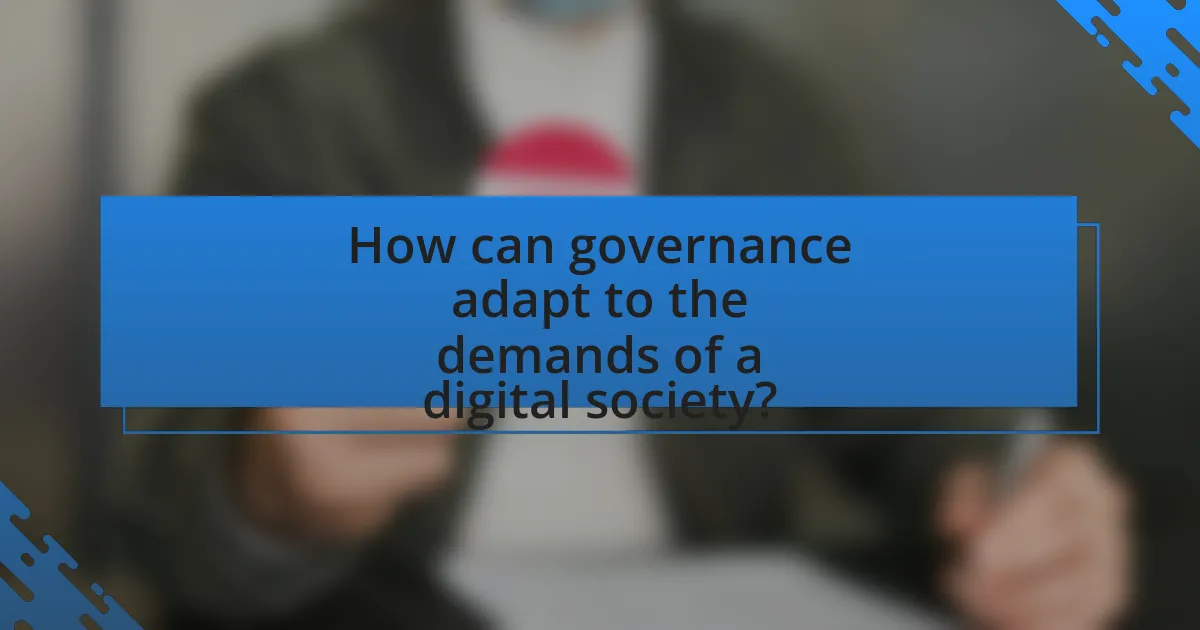The article focuses on the future of governance in a digital society, emphasizing the transformative role of technology in enhancing transparency, efficiency, and citizen engagement. It explores key technologies such as artificial intelligence, blockchain, and big data analytics that are reshaping governance practices and improving accountability. The discussion includes the challenges of data privacy, cybersecurity threats, and the digital divide, as well as strategies for effective digital governance, including stakeholder engagement and policy frameworks. Additionally, it highlights successful global examples of digital governance, providing insights into best practices and practical steps for governments to enhance their digital governance frameworks.

What does the future of governance look like in a digital society?
The future of governance in a digital society will increasingly rely on technology to enhance transparency, efficiency, and citizen engagement. Digital tools such as blockchain for secure voting, artificial intelligence for data analysis, and online platforms for public consultation will transform traditional governance structures. For instance, Estonia has successfully implemented e-governance, allowing citizens to vote online and access government services digitally, demonstrating increased participation and reduced bureaucratic delays. This shift towards digital governance is supported by the growing trend of smart cities, where data-driven decision-making improves urban management and public services.
How is technology reshaping governance practices?
Technology is reshaping governance practices by enhancing transparency, efficiency, and citizen engagement. Digital tools such as e-governance platforms allow for real-time access to government data, enabling citizens to monitor public spending and decision-making processes. For instance, the implementation of blockchain technology in public records management has been shown to reduce fraud and increase accountability, as evidenced by its use in countries like Estonia, where digital identity systems have streamlined services and improved trust in government. Additionally, social media platforms facilitate direct communication between governments and citizens, fostering participatory governance and allowing for immediate feedback on policies. These advancements illustrate how technology is fundamentally transforming the relationship between governments and the public, making governance more responsive and inclusive.
What are the key technologies influencing governance?
Key technologies influencing governance include artificial intelligence, blockchain, big data analytics, and the Internet of Things (IoT). Artificial intelligence enhances decision-making processes by providing data-driven insights, enabling governments to optimize resource allocation and improve public services. Blockchain technology ensures transparency and security in transactions, which is crucial for maintaining trust in governmental operations. Big data analytics allows for the analysis of vast amounts of information, helping policymakers understand trends and citizen needs more effectively. The Internet of Things connects various devices, facilitating real-time data collection and monitoring, which can improve urban management and public safety. These technologies collectively transform governance by increasing efficiency, transparency, and responsiveness to citizens’ needs.
How do these technologies enhance transparency and accountability?
Technologies enhance transparency and accountability by enabling real-time data sharing and tracking of actions within governance systems. For instance, blockchain technology provides an immutable ledger that records transactions and decisions, making it difficult to alter or hide information. This feature has been utilized in various public sector applications, such as voting systems, where it ensures that every vote is recorded and verifiable, thereby increasing public trust. Additionally, data analytics tools allow for the monitoring of government performance and resource allocation, facilitating informed public scrutiny and engagement. Studies have shown that governments employing these technologies experience a significant increase in citizen trust and participation, as evidenced by the 2020 report from the World Economic Forum, which highlighted that transparency initiatives led to a 30% increase in public satisfaction in governance.
What challenges does governance face in a digital society?
Governance faces significant challenges in a digital society, primarily including data privacy concerns, cybersecurity threats, and the digital divide. Data privacy concerns arise as governments collect and manage vast amounts of personal information, leading to potential misuse and erosion of public trust. Cybersecurity threats are increasingly sophisticated, with attacks on government systems posing risks to national security and public safety. Additionally, the digital divide creates inequalities in access to technology and information, hindering effective governance and participation from all societal segments. According to a 2021 report by the International Telecommunication Union, approximately 2.9 billion people remain unconnected to the internet, highlighting the urgency of addressing these disparities for inclusive governance.
How does cybersecurity impact governance structures?
Cybersecurity significantly impacts governance structures by necessitating the integration of security protocols into decision-making processes. As organizations increasingly rely on digital platforms, governance frameworks must adapt to address risks associated with cyber threats, ensuring data protection and compliance with regulations. For instance, the implementation of cybersecurity policies can enhance transparency and accountability within governance, as seen in the adoption of frameworks like the NIST Cybersecurity Framework, which provides guidelines for managing cybersecurity risks. This shift towards prioritizing cybersecurity in governance structures is essential for maintaining public trust and safeguarding sensitive information in a digital society.
What are the implications of digital divides on governance?
Digital divides significantly hinder effective governance by exacerbating inequalities in access to information and services. When segments of the population lack digital access, they are excluded from participating in decision-making processes, which can lead to a lack of representation and increased social unrest. For instance, a report by the International Telecommunication Union in 2021 indicated that over 3 billion people remain offline, limiting their ability to engage with government services and participate in civic activities. This exclusion can result in policies that do not reflect the needs of the entire population, ultimately undermining democratic principles and governance effectiveness.

How can governance adapt to the demands of a digital society?
Governance can adapt to the demands of a digital society by implementing digital tools and frameworks that enhance transparency, efficiency, and citizen engagement. For instance, the use of e-governance platforms allows for real-time communication between government entities and citizens, facilitating quicker responses to public needs. Additionally, data analytics can inform policy decisions by providing insights into citizen behavior and preferences, as evidenced by the success of smart city initiatives in places like Barcelona, which utilize data to improve urban services. Furthermore, adopting cybersecurity measures is essential to protect sensitive information and maintain public trust in digital governance.
What strategies can be implemented for effective digital governance?
Effective digital governance can be achieved through strategies such as establishing clear policies, enhancing stakeholder engagement, and leveraging technology for transparency. Clear policies provide a framework for decision-making and accountability, ensuring that digital initiatives align with organizational goals. Enhanced stakeholder engagement fosters collaboration and inclusivity, allowing diverse perspectives to shape governance practices. Leveraging technology, such as blockchain for secure transactions and data analytics for informed decision-making, increases transparency and trust in governance processes. These strategies are supported by research indicating that organizations with structured digital governance frameworks experience improved operational efficiency and stakeholder satisfaction.
How can governments leverage data analytics for decision-making?
Governments can leverage data analytics for decision-making by utilizing large datasets to inform policies and improve public services. By analyzing data from various sources, such as social media, public health records, and economic indicators, governments can identify trends, forecast outcomes, and allocate resources more effectively. For instance, the use of predictive analytics in public health has enabled governments to anticipate disease outbreaks and respond proactively, as demonstrated during the COVID-19 pandemic when data-driven models helped in resource allocation and containment strategies. This approach not only enhances the efficiency of government operations but also fosters transparency and accountability by allowing citizens to see how decisions are made based on empirical evidence.
What role does citizen engagement play in digital governance?
Citizen engagement is crucial in digital governance as it enhances transparency, accountability, and responsiveness of government services. Engaged citizens provide valuable feedback that informs policy-making and service delivery, ensuring that government actions align with public needs. For instance, studies show that participatory platforms, such as online surveys and social media, have increased citizen involvement in decision-making processes, leading to more effective governance outcomes. Additionally, research by the World Bank indicates that countries with higher levels of citizen engagement in digital governance report improved trust in government institutions and greater public satisfaction with services.
What are the best practices for implementing digital governance?
The best practices for implementing digital governance include establishing clear policies, ensuring stakeholder engagement, and leveraging technology effectively. Clear policies provide a framework for decision-making and accountability, which is essential for transparency in digital governance. Engaging stakeholders, including citizens and organizations, fosters trust and collaboration, ensuring that diverse perspectives are considered in governance processes. Additionally, leveraging technology, such as data analytics and digital platforms, enhances efficiency and accessibility, allowing for better service delivery and informed decision-making. These practices are supported by research indicating that effective digital governance leads to improved public trust and participation, as evidenced by case studies from various countries that have successfully integrated digital tools into their governance frameworks.
How can governments ensure inclusivity in digital platforms?
Governments can ensure inclusivity in digital platforms by implementing policies that promote accessibility, affordability, and digital literacy. For instance, legislation can mandate that all public digital services comply with accessibility standards, such as the Web Content Accessibility Guidelines (WCAG), which aim to make web content more accessible to people with disabilities. Additionally, governments can subsidize internet access in underserved areas, as demonstrated by programs like the Federal Communications Commission’s Lifeline program in the United States, which provides discounted phone and internet services to low-income individuals. Furthermore, investing in digital literacy programs can empower citizens to effectively use digital platforms, as evidenced by initiatives like the European Union’s Digital Education Action Plan, which aims to enhance digital skills across member states. These combined efforts create a more inclusive digital environment that accommodates diverse populations.
What frameworks exist for evaluating digital governance effectiveness?
Several frameworks exist for evaluating digital governance effectiveness, including the Digital Governance Framework, the e-Government Development Index (EGDI), and the OECD Digital Government Index. The Digital Governance Framework assesses the alignment of digital initiatives with governance objectives, focusing on transparency, accountability, and citizen engagement. The EGDI, developed by the United Nations, measures the readiness and capacity of countries to use digital technologies for public service delivery, providing a comparative analysis of global digital governance. The OECD Digital Government Index evaluates the maturity of digital government services across member countries, emphasizing user-centric service delivery and policy coherence. These frameworks provide structured methodologies for assessing the impact and efficiency of digital governance initiatives.

What is the role of public policy in shaping digital governance?
Public policy plays a crucial role in shaping digital governance by establishing the legal and regulatory frameworks that guide the use of digital technologies. These policies determine how data is collected, used, and protected, influencing the behavior of both public institutions and private entities. For instance, the General Data Protection Regulation (GDPR) implemented by the European Union sets strict guidelines on data privacy, thereby impacting how organizations manage personal information. This regulatory approach not only fosters trust among citizens but also encourages innovation by providing clear rules for digital interactions.
How can policies support the integration of technology in governance?
Policies can support the integration of technology in governance by establishing frameworks that promote digital innovation and ensure equitable access to technology. For instance, policies can mandate the adoption of e-governance platforms, which streamline public services and enhance citizen engagement. Evidence from countries like Estonia, which implemented a comprehensive digital identity system, shows that such policies can lead to increased efficiency and transparency in government operations. Additionally, policies that provide funding for technology infrastructure and training programs can help bridge the digital divide, ensuring that all citizens can benefit from technological advancements in governance.
What are the key policy areas that need to be addressed?
Key policy areas that need to be addressed in the context of adapting to a digital society include data privacy, cybersecurity, digital equity, and regulatory frameworks for emerging technologies. Data privacy policies must ensure the protection of personal information, as evidenced by the implementation of the General Data Protection Regulation (GDPR) in the European Union, which has set a global standard for data protection. Cybersecurity policies are critical to safeguard national infrastructure and individual privacy, with the Cybersecurity and Infrastructure Security Agency (CISA) reporting a significant increase in cyber threats. Digital equity initiatives are essential to bridge the digital divide, as studies show that access to technology and the internet is uneven, impacting education and economic opportunities. Lastly, regulatory frameworks for emerging technologies, such as artificial intelligence and blockchain, must be developed to address ethical concerns and promote innovation while ensuring public safety.
How can regulations keep pace with technological advancements?
Regulations can keep pace with technological advancements by adopting a flexible and adaptive framework that allows for rapid updates and revisions. This approach enables regulatory bodies to respond quickly to emerging technologies, such as artificial intelligence and blockchain, which evolve at a fast rate. For instance, the European Union’s General Data Protection Regulation (GDPR) was designed with principles that can adapt to new technologies, ensuring that privacy standards remain relevant as digital landscapes change. Additionally, engaging stakeholders from the tech industry in the regulatory process can provide insights that help shape effective policies. This collaborative approach has been shown to enhance the relevance and effectiveness of regulations in dynamic environments.
What lessons can be learned from global examples of digital governance?
Global examples of digital governance reveal several key lessons, primarily emphasizing the importance of transparency, citizen engagement, and data security. For instance, Estonia’s e-governance system demonstrates that streamlined digital services can enhance public trust and participation, as evidenced by its high voter turnout in online elections, which reached 44% in 2019. Additionally, Singapore’s Smart Nation initiative highlights the necessity of integrating technology with public services to improve efficiency and accessibility, showcasing that 90% of residents are satisfied with digital services. Furthermore, the challenges faced by countries like the United States during the rollout of healthcare.gov illustrate the critical need for robust infrastructure and user-centered design to prevent failures in digital governance. These examples collectively underscore that effective digital governance requires a commitment to transparency, user engagement, and secure data practices to foster trust and improve service delivery.
Which countries are leading in digital governance initiatives?
Estonia, Singapore, and Denmark are leading in digital governance initiatives. Estonia is recognized for its e-Residency program and digital identity system, which allows citizens to access government services online efficiently. Singapore has implemented a Smart Nation initiative, focusing on integrating technology into public services and enhancing citizen engagement. Denmark ranks high due to its digital strategy that emphasizes user-centric services and data-driven decision-making. These countries exemplify best practices in leveraging technology for effective governance, as evidenced by their high rankings in the United Nations E-Government Development Index.
What can be learned from successful digital governance case studies?
Successful digital governance case studies demonstrate the importance of transparency, citizen engagement, and data-driven decision-making. These elements lead to improved public trust and more effective service delivery. For instance, Estonia’s e-governance system allows citizens to access a wide range of services online, resulting in increased efficiency and satisfaction, as evidenced by a 99% of public services being available digitally. Additionally, Singapore’s Smart Nation initiative showcases how integrating technology into governance can enhance urban living and streamline processes, with over 80% of citizens expressing satisfaction with digital services. These examples illustrate that effective digital governance relies on leveraging technology to foster collaboration and responsiveness in public administration.
What practical steps can governments take to enhance digital governance?
Governments can enhance digital governance by implementing comprehensive digital strategies that prioritize transparency, accessibility, and security. For instance, establishing open data initiatives allows citizens to access government data, fostering transparency and accountability. According to the World Bank, countries that adopt open data policies can improve public service delivery and citizen engagement. Additionally, investing in cybersecurity measures is crucial; a report by Cybersecurity Ventures predicts that global cybercrime costs will reach $10.5 trillion annually by 2025, highlighting the need for robust security frameworks. Furthermore, governments should promote digital literacy programs to ensure that citizens can effectively engage with digital services, as evidenced by studies showing that increased digital literacy correlates with higher civic participation. By focusing on these areas, governments can significantly improve their digital governance frameworks.





